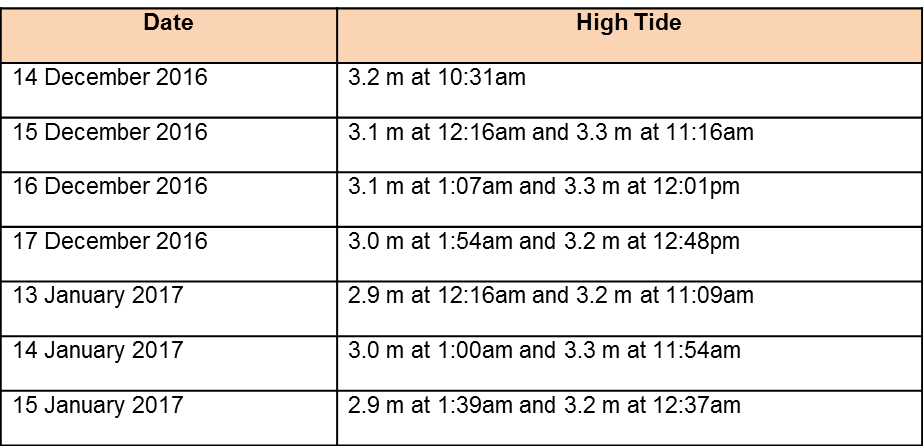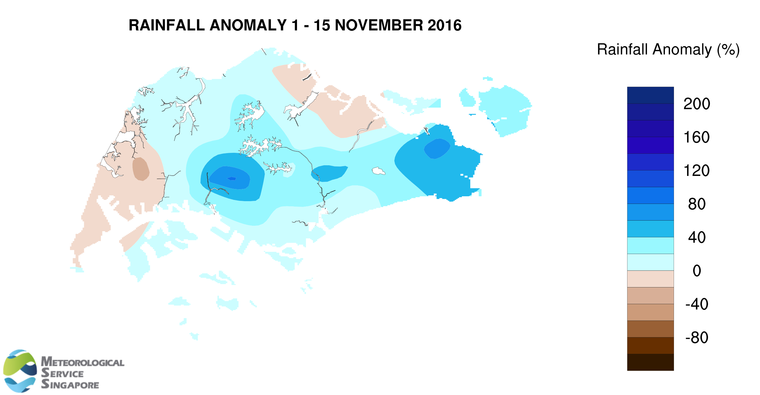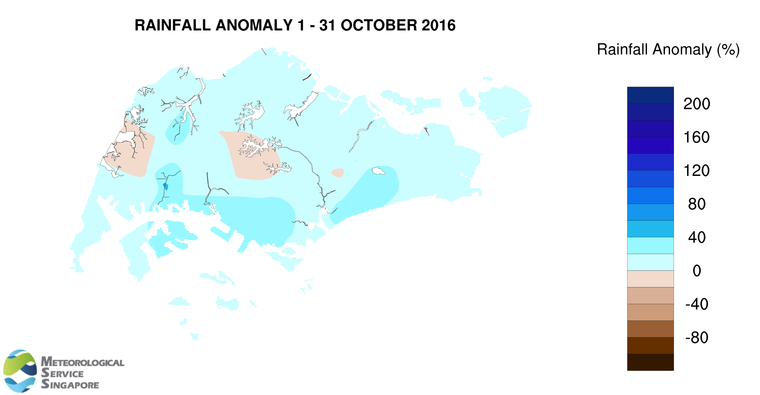JOINT ADVISORY BETWEEN PUB AND NEA
Singapore, 24 November 2016 – The Meteorological Service Singapore (MSS), forecasts that the Northeast Monsoon season is expected to onset in late November 2016. This is the traditional rainy season in the southern ASEAN region, and comprises two phases, a wet phase (December – January) and a dry phase (February – March).
2 The wet phase is characterised by short-duration moderate to heavy thundery showers mostly in the afternoon and on some days, extending into the evening. There is an average[1] of 18 rain days in December, and 13 rain days in January. The wet phase also experiences about two to four episodes of monsoon surges[2]. In contrast, the dry phase (February – March), typically brings less rainfall, drier weather conditions and occasional windy conditions compared to the December – January period.
3 During the Northeast Monsoon season, in addition to the regular weather forecast and warnings, MSS will issue prolonged monsoon heavy rain warnings when intense rain or prolonged monsoon rain is expected. This will help members of the public better prepare for periods of heavy rain.
4 In December 2016 and January 2017, high tides of at least 3.2m are expected on some days (see Table 1 below). Heavy rain coinciding with high tides could lead to localised flash floods in the low-lying areas.
Table 1 – High Tides of at least 3.2m are expected on some days in December 2016 and January 2017
—————————————————–
[1] Based on 30-yr climatological reference period (1981- 2010)
[2] Monsoon surge refers to the steady strengthening of northeasterly winds blowing from the South China Sea, and usually bring periods of prolonged, widespread, moderate to heavy rain lasting between two and five days, occasional windy conditions, and cooler temperatures to Singapore and the surrounding vicinity
Preparing for the Northeast Monsoon
5 Officers from PUB, Singapore’s National Water Agency has distributed flood advisories to around 600 residents and shop-owners in low-lying and hotspot areas, some of which are subject to tidal influence. The advisory provides tips they could take to protect their belongings and premises against possible flash floods.
6 In addition to reminding the construction industry to conduct checks on the public drains in the vicinity of their respective construction sites, PUB has inspected about 100 major construction worksites to ensure that the drains around the construction sites are free-flowing.
7 PUB has been working closely with agencies and Town Councils, to ensure that the drains and canals island-wide are clean and functioning effectively to prepare for the wet weather ahead. For example, the National Environment Agency (NEA) has increased the frequency of their checks and cleaning of drains and Drop-Inlet Chambers.
Improving Our Drainage System
8 Since 2012, PUB has adopted a holistic “Source-Pathway-Receptor” approach, which looks at catchment-wide solutions to enhance flood protection. As part of continual drainage improvement, PUB carries out upgrading of the “pathways”, through which stormwater travels.
9 Since 2013, PUB has completed drainage improvement projects at 273 locations. This year, PUB completed improvement projects at another 36 locations. These include drainage works at East Coast and Somerset Road.
10 Drainage improvement projects are currently on-going at 76 locations across Singapore. Drainage improvement works to Sunset Way outlet drain are expected to be completed in the second quarter of 2017 while works at Kallang River (between Bishan Road to Braddell Road) are expected to be completed by the fourth quarter of 2018.
11 PUB also has plans to commence drainage upgrading at 26 locations by year-end. For the list of drainage improvement projects, please refer to https://www.pub.gov.sg/Documents/PUB_Drainage_Improvement_Projects_Sept2016.pdf.
Monitoring Floods Online
12 As part of flood monitoring efforts, PUB has a network of 170 closed circuit television (CCTV) cameras to monitor real-time road conditions in low-lying areas and hotspots. Members of the public can view 49 of these CCTV images which are refreshed every five minutes.
13 PUB has 205 water level sensors installed in the island’s major drains and canals, which provide real-time data on water levels, and serve to enhance PUB’s live monitoring of site conditions during heavy storms and enable quick response. Information from all water level sensors is also available to the members of the public.
Keeping Members of the Public Informed
14 To obtain the latest weather reports, including heavy rain warnings, members of the public can tune in to radio traffic watch broadcasts, call MSS’ weather forecast hotline at 65427788, visit the MSS website at https://www.weather.gov.sg and access NEA’s mobile app MyENV, MSS’ mobile app Weather@SG or subscribe to the heavy rain warning SMS alert service provided by the MSS.
15 During heavy rain events, the public can also be updated on rising water levels in drains or canals and flash floods via PUB’s Facebook and Twitter, PUB’s free mobile app MyWaters, and PUB’s website.
16 Members of the public can also subscribe to a free SMS alert service to keep tabs on the water level in a canal or drain at a designated location via PUB’s website – https://www.pub.gov.sg/drainage/floodmanagement/subscribesms
17 In addition, selected CCTV images of road conditions in low-lying areas and hotspots can be accessed via PUB’s website or MyWaters mobile app.
18 Members of the public are advised to exercise caution during the monsoon season should flash floods occur in the event of heavy storms. Motorists should avoid driving into flooded areas, as low visibility can obscure the depth of floodwaters. Pedestrians caught in a flash flood are advised to move to higher ground and refrain from walking through flood waters.
19 Members of the public can call PUB’s 24-hour Call Centre at 1800-CALL PUB (1800-2255 782) to report on any flood situation or NEA’s hotline at 1800-6003333 to report on any choked drains.
– End –


